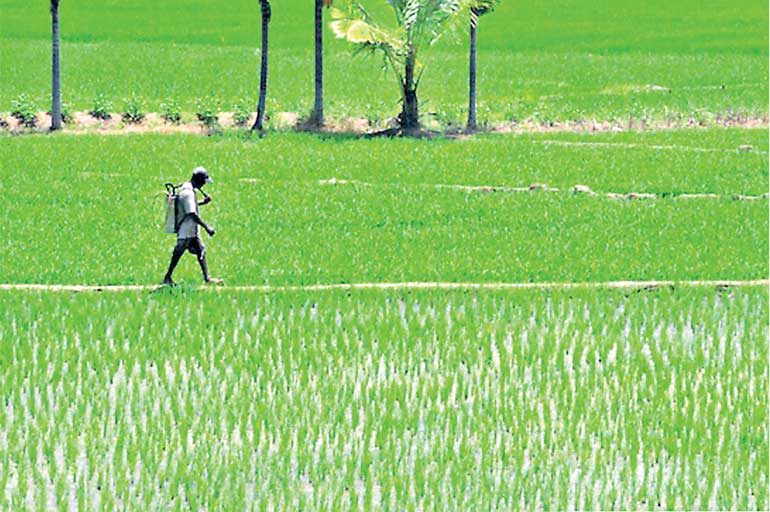Monday Dec 22, 2025
Monday Dec 22, 2025
Tuesday, 17 May 2016 00:05 - - {{hitsCtrl.values.hits}}
Introduction
Sri Lanka is heading towards a chemical and pesticide free agriculture. Paddy farming has been one of the main target areas of Sri Lanka for promoting ‘Green Agriculture’. Promotion of the green agriculture is not possible with the heavy use of chemical fertilisers  and pesticides. As a means of promoting the green agriculture the Government removed the fertiliser subsidy and a coupon system was introduced. A coupon guarantees Rs. 25,000/hectare for a year. Many argue the coupon system was ineffective since it does not allow farmers to purchase the required amount of fertiliser.
and pesticides. As a means of promoting the green agriculture the Government removed the fertiliser subsidy and a coupon system was introduced. A coupon guarantees Rs. 25,000/hectare for a year. Many argue the coupon system was ineffective since it does not allow farmers to purchase the required amount of fertiliser.
The data from the Department of Agriculture suggests that on average farmers apply 150-180 kg of fertiliser per acre. Therefore the coupon is not enough for farmers to continue applying the current rate of chemical fertilisers. However, it will push farmers to reduce the overuse of chemical fertilisers and adopt more organic fertilisers. Hence the policy decision to introduce the coupon system will be successful in the long run with adequate application of fertilisers and adoption of organic fertilisers.
In addition, the coupon system would encourage the private sector to engage in the sales of fertilisers allowing a private fertiliser market to develop. The positive outcomes of the abolition of the fertiliser subsidy will be visible only after a couple of cultivating seasons. However there are many other factors that determine the success of adoption of organic fertilisers.
The article attempts to explore these factors through answering two research questions: (1) what determines the consumption of organic fertiliser, and how that differs from the consumption determinants of inorganic fertilisers (2) what factors affects the profits of the organic paddy farmers and whether there is a difference with the inorganic farming.
The data for the analysis was collected with the financial assistance from the South Asian Network for Development and Environment Economics (SANDEE). The data collection was done during 2014-2015. The data analysis is still ongoing. The author is the lead investigator in the research project and a former Research Economist at the Institute of Policy Studies (IPS) of Sri Lanka. The author would like to acknowledge the IPS for administering the research grant.

The methodology
The use of organic and chemical fertiliser is related to the demand for fertiliser. Therefore a demand function is required to estimate the factors that influence the consumption of organic and chemical fertiliser. Since fertiliser is an essential input to the production process, the demand function is termed as an ‘input demand function’. Estimation of the input demand function can be done either as a stand-alone equation or it can be estimated as system equations, essentially deriving the input demand functions form a profit function.
The current analysis is based on the estimation of a stand-alone fertiliser demand function. Factors that determine the profits of organic and chemical paddy farmers were done by estimating a Cobb-Douglas profit function. Data collection involved six paddy-producing districts: Galle, Gampaha, Kurunegala, Anuradhapura, Matale and Kandy. Variables used in the fertiliser demand functions and the profit functions are: Family size, land size, price of organic fertiliser, price of chemical fertiliser, price of seed, cost of water management, cost of land preparation, price of bio-pesticides, price of chemical pesticides, capital intensity and output.
Results
The use of organic fertiliser is predominantly dependent up on the price of organic fertiliser, size of the paddy land and the output. Results suggest that the use of organic fertiliser would increase by almost 70% if the price of organic fertiliser were reduced by 1%. Both increased outputs and increased land sizes drive the increase use of organic fertiliser in paddy farming.
In contrast, the use of chemical fertiliser is dependent up on the cost of land preparation and the output. Increased output drives the use of chemical fertiliser higher while the increased cost of land preparation reduces the use of chemical fertilisers.
Profits of the organic paddy farmers is mainly dependent on the family size, size of the paddy land, price of organic fertiliser, price of bio pesticides, price of paddy seeds and whether the cultivation areas belongs to a commercial cultivation area or not. Family size, land area and the paddy land being situated in a commercial paddy farming area would help farmers to attain more profits. More family members would supply more family labour reducing the cost of labour.
Larger land area would allow farmers to attract economies of scale yielding more profits. Being located in a commercial paddy producing area would allow farmers to use better infrastructures such as extension services, credit facilities and marketing channels. Price of organic fertiliser, price of bio-pesticides and price of seeds affects the profits of organic farmers negatively as they increase the cost of cultivation significantly.
On the other hand, being situated in a commercial paddy producing area would enable chemical paddy farmers also to attract more profits. However the profits of the chemical based farmers would go down with an increase in the price of chemical fertilisers, price of chemical pesticides and the capital intensity.
Conclusion
The research suggests that organic fertiliser use and the profits of organic farms are dependent on many factors compared to the situation of chemical based paddy farming. Organic fertiliser use is more dependent on the price of organic fertiliser. Therefore increasing the use of organic fertiliser will be an uphill battle. Farmers are not responsive to the prices changes of chemical fertiliser however at the end of the day it affects their profits significantly. This shows the farmers tendency towards overuse of chemical fertiliser and danger to lose profits. For both farmers the profits are mainly affected by the input prices: fertiliser, seeds and pesticides.
Results further suggest that organic paddy farming has a higher probability to fail as a profit-making venture compared to chemical based farming. While the new policy on coupon system would call for the emergence of a private fertiliser market, it is important that the market is established for organic fertiliser as well. Price insensitivity of the chemical fertiliser uses could be due the heavy fertiliser subsidy until up to last cultivating season.
In practice the use of machinery is higher among the chemical based farmers and the impact of that is shown in the relationship between the capital intensity and profits of those farmers. Therefore to protect the chemical based farmers in farming activities it is important to lower the cost of capital intensity. It is important that Sri Lanka has a balance of organic and chemical based paddy framing.
Less than 10% of the farming population is on organic paddy farming and majority of them are not commercial farmers. It will take a longer time to encourage more organic farming since the use of organic fertiliser and the profits from organic farming is dependent up on many factors.
(The writer is an independent research economist; he focuses on agriculture and environment economic policy issues. He can be contacted through [email protected]).